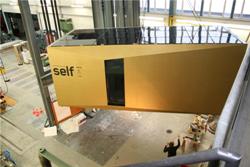Jan 19 2010
On 12th January 2010 the «Self» living module was presented publicly for the first time at the Swissbau exhibition in Basel. «Self» is a novel, highly innovative module for working and living which is self-sufficient in energy and water consumption. It includes a bedroom, bathroom, toilet and kitchen and is being used as a test bed and demonstrator for new building concepts and energy technologies by the research institutes Empa and Eawag.
 «Self» is suitable for temporary use at a wide range of different locations since the living cube is easily transported and can be placed practically anywhere.
«Self» is suitable for temporary use at a wide range of different locations since the living cube is easily transported and can be placed practically anywhere.
The «Self» living module is designed as a living area and workplace for two persons. It is about the size of a shipping container and is independent of external water and energy supplies. Because the «Self» module is easily transported and can be located almost anywhere without difficulty, it is particularly suitable for temporary use, for example as a mobile research station, an event organizer’s dwelling and office, or as an inhabited advertising vehicle, to name but a few possibilities.
Two undergraduates at the Zurich University of the Arts (ZHdK), Bjoern Olsson und Sandro Macchi, designed the Empa concept-demonstrator for their final year project, and since 2008 they have both been working together with the team led by Mark Zimmermann of Empa’s Building Technologies Laboratory on the practical implementation of their design study. As a research and demonstration project «Self» is intended to provide concrete proof that it is possible to live – at least temporarily – without loss of comfort even when making sole use of natural sources of energy. The prototype module, constructed with the help of a wide range of universities and industrial partners, is being presented for the first time at the Swissbau fair for the construction and real estate sectors held on the Basel Exhibition Site from the 12th to 16th January. In the afternoon of the first day of the exhibition, Mark Zimmermann will describe the technical details of the «Self» module and lead a guided tour through the “living cube” in the “Future of Construction” symposium.
Independent of external energy and water supplies
«Self» is 7.7 meters long, 3.45 meters wide and 3.2 meters high. Weighing in at around 5 tonnes, the container can easily be transported by truck or helicopter. The challenge for the two young designers lay in integrating the technical, supply and spatial requirements efficiently while maintaining comfort levels for the inhabitants. Technical input was provided by Empa and Eawag as well as other partner institutions and companies. In order, for example, that two persons might live in «Self» without needing external water supplies, rain water which collects on the roof of the module must be treated to make it potable, and lightly soiled washing water (“gray water”) must be recycled. In the living room a transparent 200 liter fresh water tank makes it clear to the occupants how much water they are using. Making consumption visible is an important feature for the two designers. Bjoern Olsson and Sandro Macchi are convinced that “…abstract consumption figures don’t actually mean very much. To change our behavior we need to make resource usage tangible and clearly visible.”
Testing innovative technologies and materials
Hardly any of the features of the «Self» module reflect the current state of the art – nearly everything is made of specially designed and manufactured components, one example being the shell of the container which is made of glass fiber reinforced polymer sandwich. Thermal insulation is provided by high performance vacuum insulating panels, a heat exchanger warms the fresh air using heat extracted from the exhaust air stream, the water filter operates almost without using any electric power and the toilet consumes just one liter of water per flushing cycle.
The project is also testing the practical applications of hydrogen technology – that is the synthesis, storage and usage of hydrogen for cooking and heating, for instance. The gas is generated by electrolysis using environmentally friendly electrical power supplied by solar cells on the roof of the module. Until it is required the hydrogen is stored in containers of metal hydride material, also an Empa-developed first.
For the foreseeable future the “Self” module will be used as a technology demonstrator and be exhibited at trade fairs and shows. Later Empa intends to utilize the module as living quarters for guests or as a research station in the mountains.
Source: http://www.empa.ch